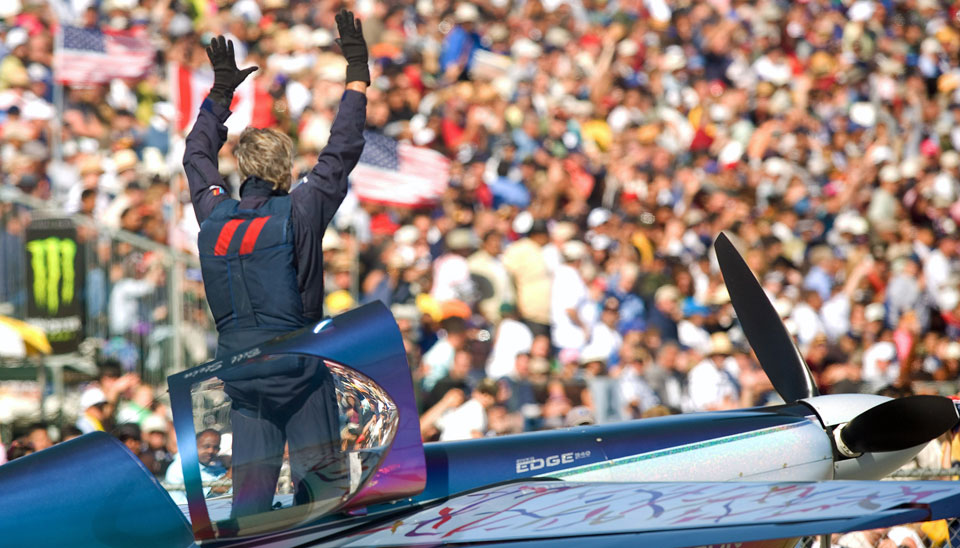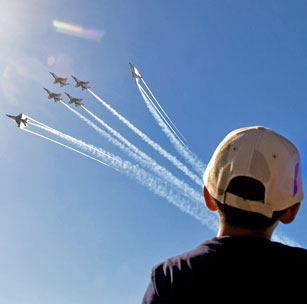
Airshows in the United States have endured many setbacks in their long history, but no single season has brought as much adversity as 2013.
First, the federal budget sequester grounded the Blue Angels and Thunderbirds, as well as military demonstration aircraft, for the entire season. Their pullout led organizers to cancel 63 shows, roughly 20 percent of the U.S. total. Since the scrubbed shows were among the season’s larger events, total airshow attendance and revenue fell disproportionately—by some estimates, more than 50 percent. (The military demonstration teams will be back for 2014, but at a somewhat reduced schedule.)
Then, on June 24, veteran wing-walker Jane Wicker and her pilot, Charlie Schwenker, were killed in a nightmarish accident in Dayton, Ohio. Video of the fiery crash was broadcast on national newscasts and replayed endlessly on the Web. Wicker’s loss was felt keenly among fellow airshow performers, among whom she was a popular, respected, and encouraging personality.
Finally, near the end of the season, the FAA announced its intention to impose major fees for ATC services at aviation events large and small. EAA’s AirVenture was billed more than $450,000 for services that used to be provided free, and EAA paid the bill while it challenges the FAA policy in federal court.
Any one of these developments would have been a major challenge to the airshow industry, but taken together they call into question the viability of future airshows and whether they can continue in their current form.
Formula for success
“Before 2012 the formula for airshow success was pretty straightforward,” said John Cudahy, president of the International Council of Air Shows in Leesburg, Virginia. “Get a jet team, and fill in with a diverse group of performers. But that formula doesn’t work without the main attraction.”
The military flight demonstration teams are relatively small pawns in a far larger philosophical and economic standoff that is the subject of ongoing federal budget negotiations. “We make our case as forcefully as we can,” Cudahy said. “But the politics of the sequester are being played out at such a high level in government that airshows get overlooked.”
While the big U.S. airshows that depend on mass-market appeal have suffered from the loss of military support, small shows—the ones that never had a chance of attracting a jet team—have done relatively well. Events such as Thunder Over Michigan, Wings Over Houston, and the Commemorative Air Force’s annual Airsho in Midland, Texas, drew significant numbers of aviation enthusiasts who know and appreciate the largely historical aircraft featured at these events.
Also, civilian formation teams such as the Black Diamonds, which use L–39 jets; Team AeroDynamix, which flies the RV series of kit airplanes; and the AeroShell Team, which consists of four T–6s, take on a new significance in the absence of military teams.
The high-profile deaths of Wicker and Schwenker created a public perception that airshow accidents are on the rise, so it may seem surprising that there were fewer fatal crashes in 2013 than any year in the past decade. There were 3.4 fatal accidents per year in the mid-2000s and fewer than two accidents a year in the past six years.
“People who come to airshows don’t expect to see accidents, and they don’t want to see accidents,” Cudahy said. “They’re terrible for spectators, organizers, and performers alike.”
A scrapper
In response to new economic realities, airshow performers are altering their marketing and their routines to appeal to a broader audience.
Greg Koontz, an aerobatic pilot, brings his Alabama Boys comedy routine to about 20 airshows annually. He’s also focusing on smaller airshows and has begun sharing the financial risk with some of them. “If a two-day event gets rained out for one day, I won’t charge for the day we don’t fly,” he said. “The small shows are taking a risk, and I’m willing to share the risks along with the rewards.” (See “P&E: What To Do When You’re Upside Down,” page 76.)
Koontz also teaches aerobatic flying to fly-in guests at his private airfield in northern Alabama, and he sells airplanes for American Champion. If airshow bookings decline, he builds in his other related business ventures. “I’m a scrapper,” Koontz says. “I teach, run a bed and breakfast, do airshows, and sell airplanes. They’re all complementary.”
John Klatt, also a veteran aerobatic performer, regards the 2013 season as an anomaly and says airshows are too deeply ingrained in the American psyche to ever go away completely. Klatt is building a new aircraft that he planned to unveil in early December at the International Council of Air Shows convention in Las Vegas.
“Airshows are deeply embedded in our culture—and they’re very important for inspiring people and bringing them into aviation,” Klatt said. “I’m making a big investment in the future of airshows with the jet Waco, and that’s the kind of thing it’s going to take to capture people’s imaginations. Airshows will evolve, but they’re not going away.”
Cudahy said he’s convinced that the airshow industry will adapt with a series of new offerings. There may be different venues, new aircraft, or altered economic models, but airshows will be forced to reinvent themselves—sequester or not.
“I’m optimistic that we can create quality entertainment that attracts large numbers of people, with or without the jet teams. The capacity is there. I trust the creativity and the entrepreneurial spirit of the airshow industry.”
Email [email protected]

Screened and tested
Performers at today’s airshows are screened and tested more than ever. Airshow pilots are required to meet annually with an aerobatic competency evaluator (ACE), an industry veteran who reviews their planned maneuver sequences, watches them fly, and assigns a “floor” for their flights.
Pilots new to airshows typically are authorized a minimum altitude of 800 feet agl. As they gain experience, that floor can be lowered to 500 feet, 250 feet, and finally “unrestricted.” Getting to the unrestricted or surface level typically takes years of airshow flying and dozens of performances.
For example, moving from 800 feet to 500 feet requires performing in at least eight airshows at five different sites. Dropping from 500 feet to 250 requires a dozen performances at a minimum of six locations, and getting an unrestricted waiver means flying at least 16 performances at eight different places.
An airshow performer who violates minimum altitudes, flies too close to spectators, or is deemed unsafe can be grounded at any time.
There are 62 ACEs in the United States for sport aerobatics, 29 covering jet warbirds, and 10 for wing walkers. The 80-page ACE manual is available on the Web (www.airshows.aero) and covers the entire evaluation process.
Flight evaluations for pilots seeking to perform in state-of-the-art aerobatic airplanes (such as an Extra, Edge, Pitts, or Sukhoi) include such maneuvers as a pair of 180-degree inverted turns, a 3-turn inverted spin, vertical rolls, and gyroscopic maneuvers. Pilots seeking to perform in less capable airplanes (such as a stock Stearman biplane or a clipped-wing Piper Cub) must perform ailerons rolls, point rolls, loops, and hammerheads.
The evaluation process is administered by the International Council of Air Shows.—DMH



